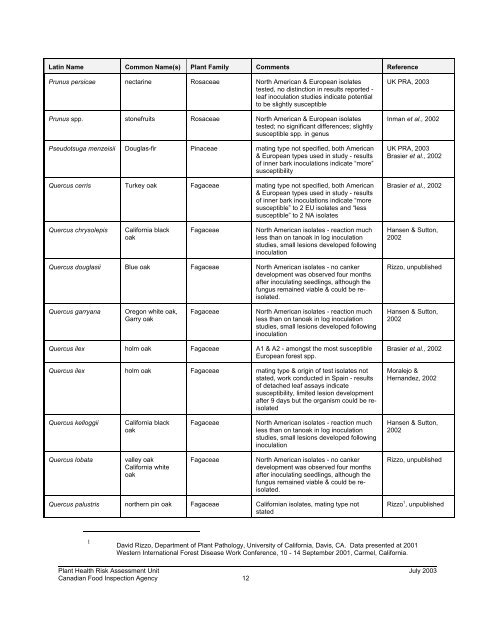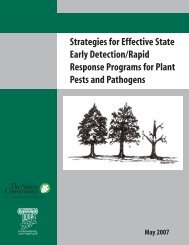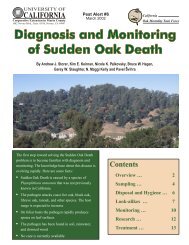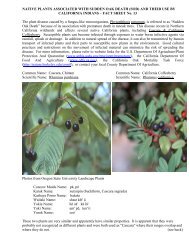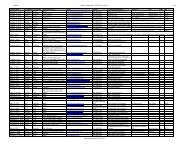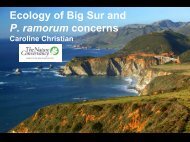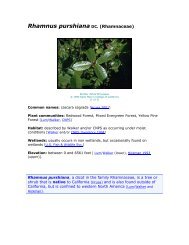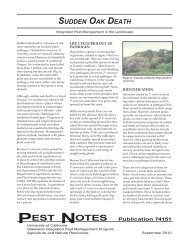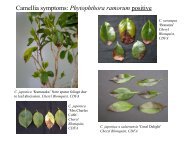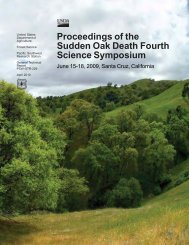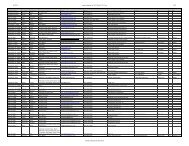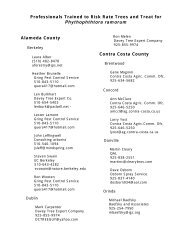Hosts of Phytophthora ramorum, CFIA, July, 2003 - Sudden Oak Death
Hosts of Phytophthora ramorum, CFIA, July, 2003 - Sudden Oak Death
Hosts of Phytophthora ramorum, CFIA, July, 2003 - Sudden Oak Death
You also want an ePaper? Increase the reach of your titles
YUMPU automatically turns print PDFs into web optimized ePapers that Google loves.
Latin Name Common Name(s) Plant Family Comments Reference<br />
Prunus persicae nectarine Rosaceae North American & European isolates<br />
tested, no distinction in results reported -<br />
leaf inoculation studies indicate potential<br />
to be slightly susceptible<br />
Prunus spp. stonefruits Rosaceae North American & European isolates<br />
tested; no significant differences; slightly<br />
susceptible spp. in genus<br />
Pseudotsuga menzeisii Douglas-fir Pinaceae mating type not specified, both American<br />
& European types used in study - results<br />
<strong>of</strong> inner bark inoculations indicate “more”<br />
susceptibility<br />
Quercus cerris Turkey oak Fagaceae mating type not specified, both American<br />
& European types used in study - results<br />
<strong>of</strong> inner bark inoculations indicate “more<br />
susceptible” to 2 EU isolates and “less<br />
susceptible” to 2 NA isolates<br />
UK PRA, <strong>2003</strong><br />
Inman et al., 2002<br />
UK PRA, <strong>2003</strong><br />
Brasier et al., 2002<br />
Brasier et al., 2002<br />
Quercus chrysolepis<br />
California black<br />
oak<br />
Fagaceae<br />
North American isolates - reaction much<br />
less than on tanoak in log inoculation<br />
studies, small lesions developed following<br />
inoculation<br />
Hansen & Sutton,<br />
2002<br />
Quercus douglasii Blue oak Fagaceae North American isolates - no canker<br />
development was observed four months<br />
after inoculating seedlings, although the<br />
fungus remained viable & could be reisolated.<br />
Rizzo, unpublished<br />
Quercus garryana<br />
Oregon white oak,<br />
Garry oak<br />
Fagaceae<br />
North American isolates - reaction much<br />
less than on tanoak in log inoculation<br />
studies, small lesions developed following<br />
inoculation<br />
Hansen & Sutton,<br />
2002<br />
Quercus ilex holm oak Fagaceae A1 & A2 - amongst the most susceptible<br />
European forest spp.<br />
Quercus ilex holm oak Fagaceae mating type & origin <strong>of</strong> test isolates not<br />
stated, work conducted in Spain - results<br />
<strong>of</strong> detached leaf assays indicate<br />
susceptibility, limited lesion development<br />
after 9 days but the organism could be reisolated<br />
Brasier et al., 2002<br />
Moralejo &<br />
Hernandez, 2002<br />
Quercus kelloggii<br />
California black<br />
oak<br />
Fagaceae<br />
North American isolates - reaction much<br />
less than on tanoak in log inoculation<br />
studies, small lesions developed following<br />
inoculation<br />
Hansen & Sutton,<br />
2002<br />
Quercus lobata<br />
valley oak<br />
California white<br />
oak<br />
Fagaceae<br />
North American isolates - no canker<br />
development was observed four months<br />
after inoculating seedlings, although the<br />
fungus remained viable & could be reisolated.<br />
Rizzo, unpublished<br />
Quercus palustris northern pin oak Fagaceae Californian isolates, mating type not<br />
stated<br />
Rizzo 1 , unpublished<br />
1<br />
David Rizzo, Department <strong>of</strong> Plant Pathology, University <strong>of</strong> California, Davis, CA. Data presented at 2001<br />
Western International Forest Disease Work Conference, 10 - 14 September 2001, Carmel, California.<br />
Plant Health Risk Assessment Unit <strong>July</strong> <strong>2003</strong><br />
Canadian Food Inspection Agency 12


